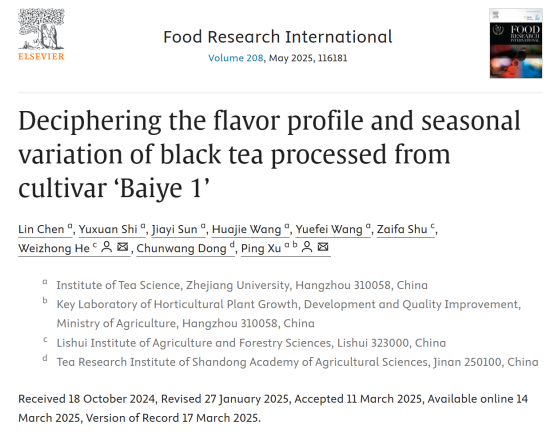
导读
近日,浙江大学徐平教授所在研究团队在《Food Research International》发表了一项最新研究,深入探讨了‘白叶1号’红茶的风味物质基础和形成机制。研究通过聚焦于‘白叶1号’这一高氨基酸含量的茶树品种,通过感官评价和代谢组学分析,深入探讨了其制成红茶(BYBT)的风味特征及其随季节的变化规律。研究发现,BYBT具有独特的橙红色汤色、甜薯或蜂蜜香气,以及甜、鲜、清淡的口感。通过挥发物分析,鉴定出110种特征性挥发物,确定了来源于脂质氧化和类胡萝卜素降解的29种挥发性代谢物(包括具有甜香的β-紫罗兰酮)可能是其甜香的关键贡献化合物。此外,研究还发现,不同季节的‘白叶1号’红茶在挥发物组成上存在显著差异,其中春季红茶的甜香更为浓郁,这与其较高的β-罗勒烯、香叶醇、柠檬醛含量有关。BYBT中氨基酸及糖类含量较高,而多酚类的含量较低,对其鲜味和甜味的滋味特点有重要影响。该研究通过深入解析不同季节红茶的风味差异,为开发新型红茶产品及其衍生品提供了科学依据,同时也为茶叶加工技术的创新和红茶品质的提升提供了重要参考。
英文摘要
Black tea flavor is predominantly shaped by the internal composition of the materials utilized, and black teas produced from high-polyphenol varieties is typically characterized by a stronger, bitter, astringent taste with a low aroma intensity. Therefore, understanding the flavor profile and material basis of black tea produced from high-amino acids tea plants may be helpful to enhance flavor and innovate black tea products. Here, by sensory evaluation and metabolomics analysis, it was found that the typical flavor of 'Baiye 1' black tea (BYBT) was orange-red solution color, a sweet potato-like or sweet honey-like aroma, and a sweet, umami, and light taste. A total of 110 characteristic volatiles of BYBT were identified, among which 29 metabolites, including β-ionone with a sweet aroma, may be considered the key compounds responsible for the sweet aroma. The geraniol, cis-3-hexenyl isovalerate, and n-valeric acid cis-3-hexenyl were key volatiles that distinguish different seasons. Additionally, 7 volatiles, including β-ocimene, geraniol, citral, were the crucial metabolites responsible for the stronger sweet or honey aroma of BYBT in spring. The lower tea polyphenols and the higher amino acids and sugars shaped the BYBT profile with distinct umami and sweetness, as well as a light taste. Amino acids, catechins and their derivatives were the most significantly affected by seasonal variations in BYBT, and were also responsible for the differences in taste and color quality observed between samples with different seasons. The findings of this study provided a scientific foundation for the development of novel black tea products or derivatives thereof.
代表性图片
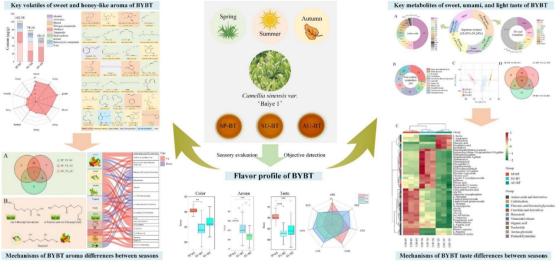
▲摘要图
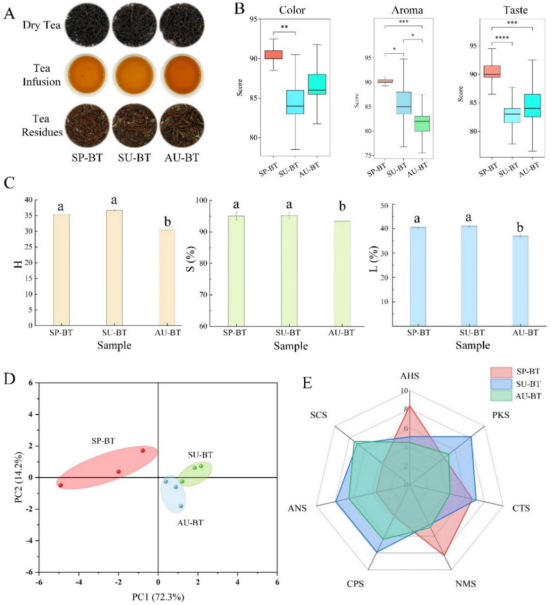
▲ 不同季节的 ‘白叶1号’红茶(BYBT)的感官品质分析。(A)不同BYBT的干茶、茶汤和叶底图片;(B)不同BYBT的感官评分;(C)颜色参数,特别是不同BYBTs茶汤的H、S、L值;(D)不同BYBT电子舌数据的主成分分析;(E)电子舌数据雷达图
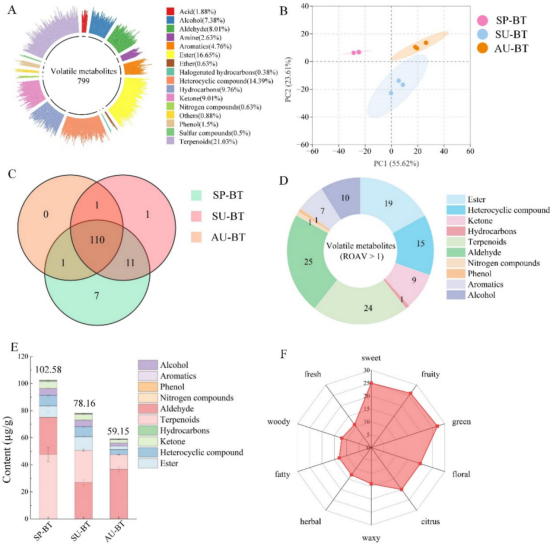
▲ 不同季节BYBT的香气和挥发性代谢物特征。(A)三个样品中挥发物分类含量圆环图;(B)主成分分析;(C)SP-BT、SU-BT和AU-BT的Venn图;(D)ROAV≥1的挥发性化合物数量圆环图;(E)三个季节红茶样品中不同挥发性化合物的含量;(F)三个季节红茶样品中ROAV>1的共有挥发性化合物风味雷达图
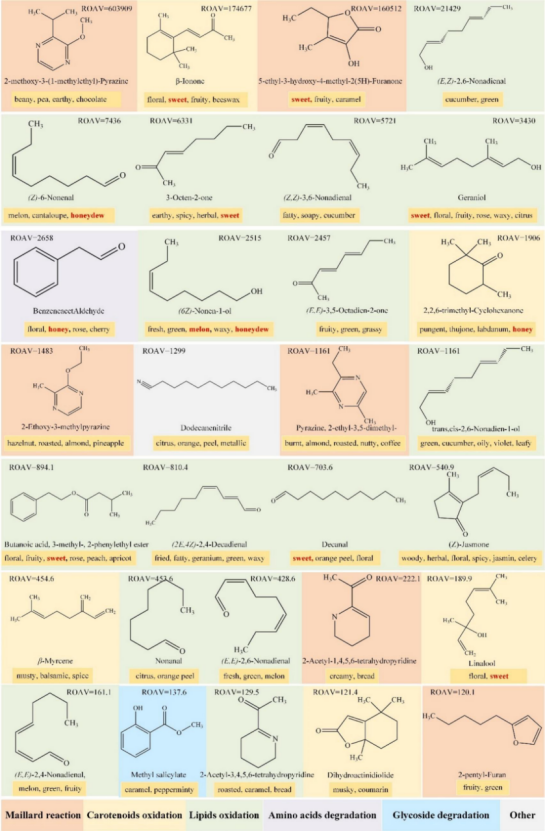
▲ BYBT中ROAV>1的前30种挥发性代谢物的结构、名称、风味特征、ROAV值和形成途径
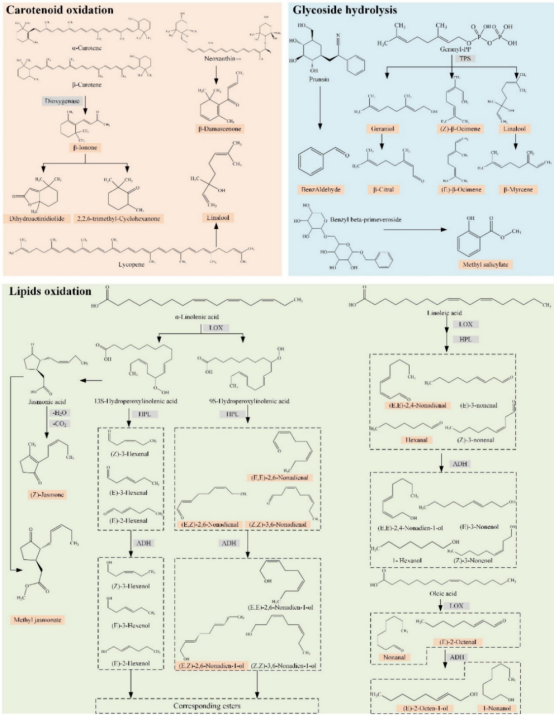
▲ BYBT中部分挥发物的合成途径
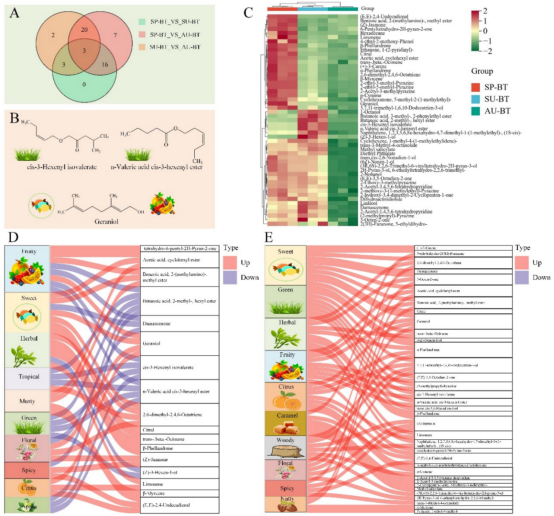
▲ 不同季节BYBT的挥发性代谢物差异分析。(A)Venn图;(B)不同季节BYBT的中常见差异挥发性化合物的结构和风味;(C)51种差异挥发性化合物热图;(D)SU-BT和SP-BT比较中差异挥发性化合物风味和含量变化桑基图;(E)AU-BT和SP-BT比较中差异挥发性化合物风味和含量变化桑基图
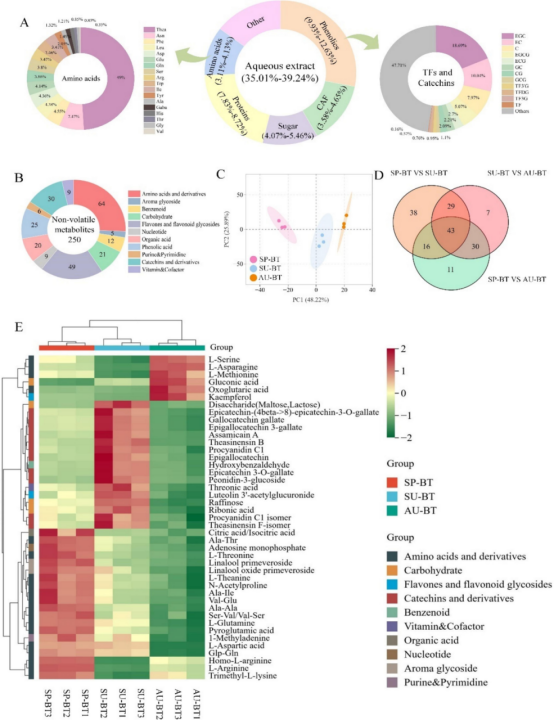
▲ 不同季节BYBT的非挥发性代谢物分布特征。(A)红茶茶汤的主要成分;(B)三个季节样品中非挥发性化合物含量分类圆环图;(C)主成分分析;(D)不同对比组的韦恩图;(E)三个组别中存在显著差异的非挥发性化合物热图
审稿:中国农业科学院茶叶研究所 李佳副研究员
来源: 中国茶叶学会
内容资源由项目单位提供


 科普中国公众号
科普中国公众号
 科普中国微博
科普中国微博

 帮助
帮助
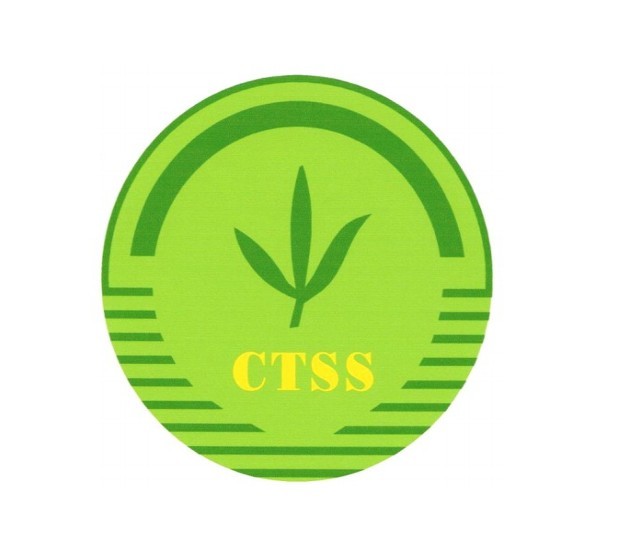 中国茶叶学会
中国茶叶学会 
